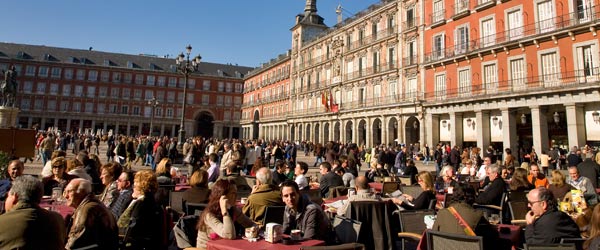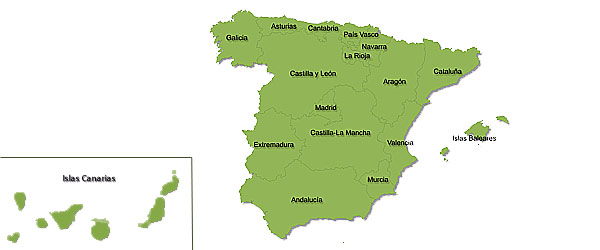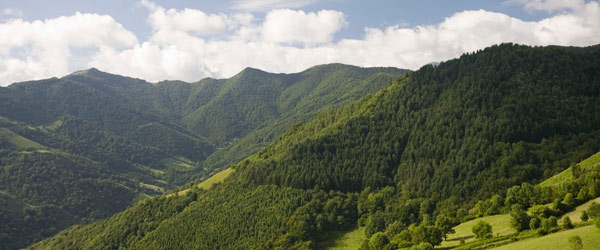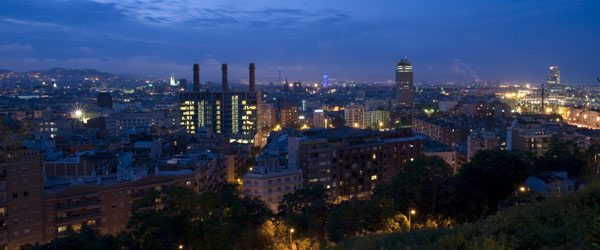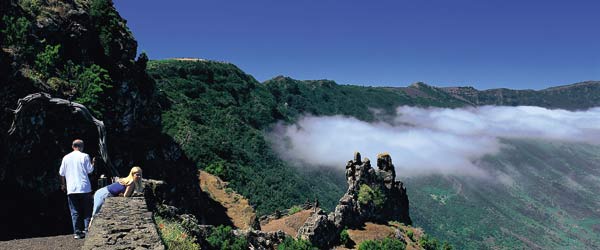Spain and its regions
Spain is one of the largest countries in Europe, so if you're thinking of travelling around, it's a good plan to have a general idea of what you can find in each area with regard to its culture, natural attractions and gastronomy. Spain has 17 autonomous regions (including the archipelago of the Canary Islands in the Atlantic Ocean and the archipelago of the Balearic Islands in the Mediterranean Sea), and two autonomous cities in northern Africa: Ceuta and Melilla. Each autonomous region is itself divided into provinces, making a total of 52..
Every one of them will pleasantly surprise you with its cities, monuments, culinary fare, its typical festivities... The contrasting landscapes (ranging from what is known as "Green Spain" in the north, to endless sandy beaches in the south) are also guaranteed to captivate you. We also recommend you check our section on "Climate" to find out what type of weather to expect in each area, as the interior tends to be colder than the coastal areas while the north is usually wetter.
Remember too that although Spanish is the official language throughout the country, certain autonomous regions have other co-official languages. This is the case of Euskera in the Basque Country, Gallego in Galicia, Catalan in Catalonia and Valencian in the Region of Valencia.
The five provincial capitals with the largest populations in Spain are: Madrid, Barcelona, Valencia, Seville and Zaragoza, in that order.
What's more, there are others cities with smaller populations but which have a great university tradition such as Salamanca, Granada and Santiago de Compostela.
Would you like to find out something about each autonomous region? Here we group them according to their location:
In northern Spain, known as "Green Spain", you'll find:
Region of Asturias
From the cultural standpoint, in the city of Oviedo you'll find monuments like the churches of Santa María del Naranco, San Miguel de Lillo and San Juan de Prados (awarded the World Heritage designation by the UNESCO), and the caves containing examples of priceless prehistoric rock art to be found throughout Asturias.
Asturias is also home to such spectacular landscapes as the mountains in the Picos de Europa National Park, and beautiful beaches in towns and villages like Llanes, Ribadesella, Gijón and Cudillero.
The region's gastronomic delicacies include Cabrales cheese, the white bean stew known as "fabada asturiana" and the typical Asturian cider.
Cantabria
If you're going to study there, you'll have the chance to visit monuments such as the Magdalena Palace in Santander, the monastery of Santo Toribio de Liébana, and Gaudí's "Capricho" monument in Comillas. In this part of Spain you'll also find the prehistoric caves of Altamira, declared a World Heritage site by the UNESCO.
Highlights from among its spectacular landscapes are its beaches and the Picos de Europa National Park.
Some of the typical dishes of the local gastronomy are the bean stew known as "cocido montañés", "sobaos" (sponge cakes) and "quesada pasiega" (a type of cheesecake).
Galicia
Provinces: A Coruña, Lugo, Ourense y Pontevedra
Santiago de Compostela is the ultimate destination for the pilgrims on the world-famous Way of Saint James, and is also a university city with a very lively atmosphere.
Galicia is also home to monuments such as the Torre de Hercules tower in A Coruña and the city walls in Lugo (both designated World Heritage sites by the UNESCO) that are guaranteed to make an impression.
All along the length of its coastline, bathed by the Cantabrian Sea and the Atlantic Ocean, you'll find areas of spectacular cliffs like those on A Costa da Morte, or the incredible Islas Atlánticas National Park.
The region's delicious gastronomy will be one of the strong points if you're lucky enough to be living in Galicia, with unforgettable products and dishes such as shellfish, veal, "pulpo a feria" (octopus with potatoes)...
Basque Country
Provinces: Áraba-Alava, Gipuzkoa y Bizkaia
One of its most important cities, Bilbao, is home to the Guggenheim Museum.
Not should you miss the Bizkaia suspension bridge, awarded World Heritage status, the Kursaal Palace in Donostia-San Sebastián, and the historic quarter of Vitoria-Gasteiz.
And as for its natural attractions, you're certain to enjoy coastal destinations like Zarautz, Getxo…
And of course when you're in the Basque country, you're bound to want to go out with your friends to try the famous “pintxos” (miniature gastronomic treats that you'll see arranged on the bars in numerous venues), or sample dishes such as "cocochas de merluza" (hake morsels) and "marmitaco" (tuna and potato stew).
In the Mediterranean, an area of warm temperatures, you'll find:
Catalonia
Provinces: Barcelona, Girona, Lleida and Tarragona
This is a land that is home to the creations of artists such as Gaudí and Dalí. Here you'll find monuments like the Sagrada Familia church in the city of Barcelona (one of Spain's best-known destinations), the archaeological site of Tarraco, the churches of the Vall de Boí valley in Lleida… and important museums like the Dalí Theatre-Museum in Figueres.
You'll also be able to enjoy its beaches (in places such as Salou, Sitges, Cadaqués, Lloret de Mar and Roses), and the landscapes of the Catalan Pyrenees and the Aigüestortes y Estany de Sant Maurici National Park.
This part of Spain has some of the best restaurants in the world, and is known for traditional dishes such as “pa amb tomàquet” (bread and tomato).
Region of Valencia
Provinces: Castellón-Castelló, Valencia and Alicante-Alacant.
In the city of Valencia you'll be able to visit the City of Arts and Sciences, and enjoy the world-famous bonfire festival known as the Fallas de San José (in March).
A dip at its beaches bathed by the Mediterranean Sea is always a luxury, and if you're a nature lover, why not take a trip to explore the Palmeral de Elche palm grove, designated a World Heritage site by the UNESCO?.
The gastronomy of the Region of Valencia is a fine example of the Mediterranean diet, and features products and dishes that you'll see in abundance during your stay such as oranges, paella and "horchata" (a cooling drink made with tiger nuts).
Region of Murcia
Murcia is home to a historical mixture of cultures that can be seen in its monuments, including particularly the Cathedral in the city of Murcia itself.
Its coastline is known as the Costa Cálida. In fact, one of its most famous areas, the Manga del Mar Menor, is the ideal place for enjoying the mild climate and relaxing. What's more, you'll also find a wide variety of protected nature areas.
Its culinary attractions include the cuisine from the Huerta de Murcia (a fertile area of market gardens) in addition to its roasts, salt-cured products, and fish and seafood from the Mar Menor.
Balearic Islands
The main islands in this archipelago are Majorca, Minorca, Ibiza and Formentera, although there are also other smaller islands such as those to be found in the Cabrera Archipelago National Park.
Culture has a particularly importance in these islands, and the attractions include places such as the cathedral and Bellver Castle in Palma (in Majorca), and the island of Ibiza, declared a World Heritage site thanks to its biodiversity and its culture (and also famous for its exciting nightlife).
You can also make the most of your stay in the Balearic Islands by taking a dip in the lovely coves, or exploring Minorca, declared a Biosphere Reserve.
And you can't possibly leave without trying the cheese from Mahón, the "sobrasada" (a kind of chorizo spread), and the typical pastry known as "ensaimada".
In the interior of Spain, an extensive land of contrasts, you will find:
Aragon
Provincias: Huesca, Zaragoza and Teruel
Aragon is the homeland of the famous painter Francisco de Goya. Once there, you should on no account miss a visit to its monuments of Mudéjar architecture which have been awarded the World Heritage designation by the UNESCO, as well as other well-known sights like the Basilica of Nuestra Señora del Pilar in Zaragoza, one of the largest cities in Spain.
And if you're a nature lover, you should definitely make time for a visit to the Ordesa y Monte Perdido National Park and to the Pyrenees. This area is also highly recommended in winter for skiers.
From the point of view of gastronomy, what could be better than to sample the wines with their own Designation of Origin such as Somontano, or the famous cured ham from Teruel?
Castile-La Mancha
Provinces: Albacete, Ciudad Real, Cuenca Guadalajara and Toledo
This is the setting for the adventures of the famous literary character Don Quixote of La Mancha. We recommend that you explore its World Heritage cities, such as Cuenca with its Hanging Houses, and Toledo with its cathedral and its Alcázar fortress.
Its natural attractions include particularly the National Parks of Tablas de Daimiel and Cabañeros.
The typical products of the local gastronomy include honey from La Alcarria and marzipan from Toledo, in addition to the numerous wineries where you can sample wines such as Valdepeñas.
Castile-León
Provinces: Ávila, Burgos, León, Palencia, Salamanca, Segovia, Soria, Valladolid and Zamora.
We can recommend many of its destinations such as Avila, Salamanca with its well-known university atmosphere, Segovia (these three are all World Heritage cities), and Valladolid, in addition to unique places such as Burgos cathedral or the archaeological site of Atapuerca.
If you would like to enjoy some unforgettable scenery, we recommend a visit to the Picos de Europa National Park or to Las Médulas, an open-air goldmine excavated during the Roman Empire.
Gastronomic specialities include such delicacies as roast milk-fed lamb, black pudding, "botillo" (a dish of cured spiced pork), roast suckling pig… and wines from the Ribera de Duero.
Extremadura
Provinces: Badajoz y Cáceres
In the city of Mérida you should on no account miss its archaeological site.
The historic quarter of the city of Cáceres is also well worth a visit, as is the Royal Monastery of Santa María de Guadalupe in the area nearby.
Another of its attractions is its natural setting, in which the highlights include the Monfragüe National Park, and the Jerte valley.
And of course during your stay you'll be able to sample the world-renowned cured ham raised in the wooded pastures of Extremadura.
Madrid Region
It is located in the very heart of Spain, and this is the site of the capital of the country, the city of Madrid. Here, in addition to an extensive list of cultural events, you'll find the world-famous Prado Museum, and monuments like the Royal Palace.
But as you'll see, the Madrid Region offers much, much more. For example, the towns of Aranjuez, Alcalá de Henares (the birthplace of Cervantes and the ideal place for learning Spanish) and San Lorenzo del Escorial, all home to cultural treasures that have been awarded the World Heritage status.
And if you want to get away and head for a natural setting, Madrid is also home to places that are perfect for a break such as the mountains of the Sierra de Guadarrama.
In Madrid, particularly in the city, you'll find restaurants to suit every taste, but there are also typical dishes such as the chickpea stew known as "cocido madrileño", and the tripe known as "callos a la madrileña".
Navarre
This area of Spain is known above all for the bull-running festivities known as the Sanfermines which are held every year in the city of Pamplona in July. But Navarre is also a land of castles, and a number of other monuments such as the collegiate church of Santa María de Orreaga/Roncesvalles.
And if you're interested in its natural treasures, why not pay a visit to the extensive Irati forest, or to the desert of the Bardenas Reales?
Navarre has a very varied gastronomy, in which the star turns are its fresh garden-grown vegetables, the exquisite canapés known as "pinchos", and its wines.
La Rioja
In addition to its capital, Logroño, you'll be able to explore other places such as Santo Domingo de la Calzada and its cathedral, and San Millán de la Cogolla which is the site of the monasteries of Suso and Yuso, awarded World Heritage status by the UNESCO and known for being the birthplace of the first written words in the Spanish language.
This is the first stop on the Route of the Spanish Language, and in fact, this area of Spain has numerous centres which are dedicated to the dissemination of the Castilian tongue.
Its natural attractions include particularly the Arnedillo Biosphere Reserve.
But if this area of Spain is known for something, it is for its world-famous wines; the region is home to over 500 wineries.
In southern Spain, synonymous with sun and enthusiasm, you'll find:
Andalusia
Provinces: Almería, Cádiz, Córdoba, Granada, Huelva, Jaén, Málaga and Sevilla.
In Andalusia you'll find sites that have been awarded the World Heritage designation by the UNESCO such as the Alhambra in Granada (one of the most popular cities with students), the Great Mosque of Cordoba, and Seville Cathedral; museums like the Picasso in Malaga, and you'll also have a chance to enjoy events such as the Easter week commemorations, carnival in Cadiz, the Rocío pilgrimage in Huelva, and the April Fair in Seville.
Its natural attractions include the famous beaches to be found in this part of Spain, in addition to areas such as the National Parks of Doñana and Sierra Nevada.
The local gastronomy features the sherries of Jerez (Cadiz) and Montilla–Moriles (Cordoba), and the classic platters of fresh fried fish known as "pescaíto frito" from Cadiz and Malaga, cured ham from Huelva and Cordoba, olive oil, and other such typical dishes as gazpacho and "salmorejo" (a kind of thicker gazpacho).
Further south from the Iberian Peninsula you'll find:
Canary Islands
Provinces: Santa Cruz de Tenerife and Las Palmas
These are located a little over 1,000 kilometres to the south of the Iberian Peninsula and features an archipelago formed by seven islands with volcanic origins: Tenerife, Gran Canaria, Fuerteventura, La Gomera, Lanzarote, La Palma and El Hierro.
If you choose this is your destination during your studies, you will enjoy an average year-round temperature of 22ºC on the coasts, and a multitude of beaches where you can take a dip.
The island of Tenerife is home to a World Heritage City: San Cristóbal de la Laguna. What's more, on several of the islands you'll find examples of original works by César Manrique.
You'll be able to see for yourself the different and spectacular natural landscapes in its four National Parks, including various perfect sites for observing volcanic craters, a forest of laurisilva…
When choosing what to eat during your stay, make a point of trying the "papas con mojo" (potatoes with a spicy sauce), Canary Islands bananas, and Majorero cheese.
Autonomous cities of Ceuta y Melilla
Both cities are located in the north of the African continent (although they are separated from each other by about 400 kilometres), and are distinguished by their mixture of four different cultures: Christian, Muslim, Hindu and Jewish.
Sites worth visiting in Ceuta include the Mediterranean Maritime Park (designed by César Manrique) and its defensive walls, while Melilla is known above all for its Modernist architecture.
If you are a fan of water sports like scuba diving, you'll love both these cities.
And with regards to gastronomy, you'll find a combination of the regional cooking of southern Spain with elements from the cuisine of North Africa. You'll be able to try fresh fried fish, kebabs, stuffed dates…
More information
To make the most of your stay in Spain we recommend that you check the official Spanish websites for tourism and culture:
http://www.spain.info/
http://www.spainisculture.com/







